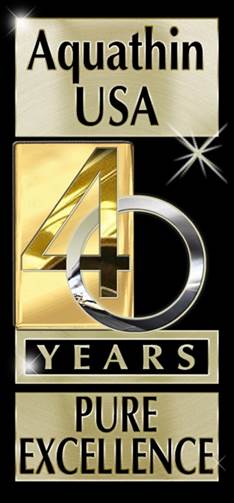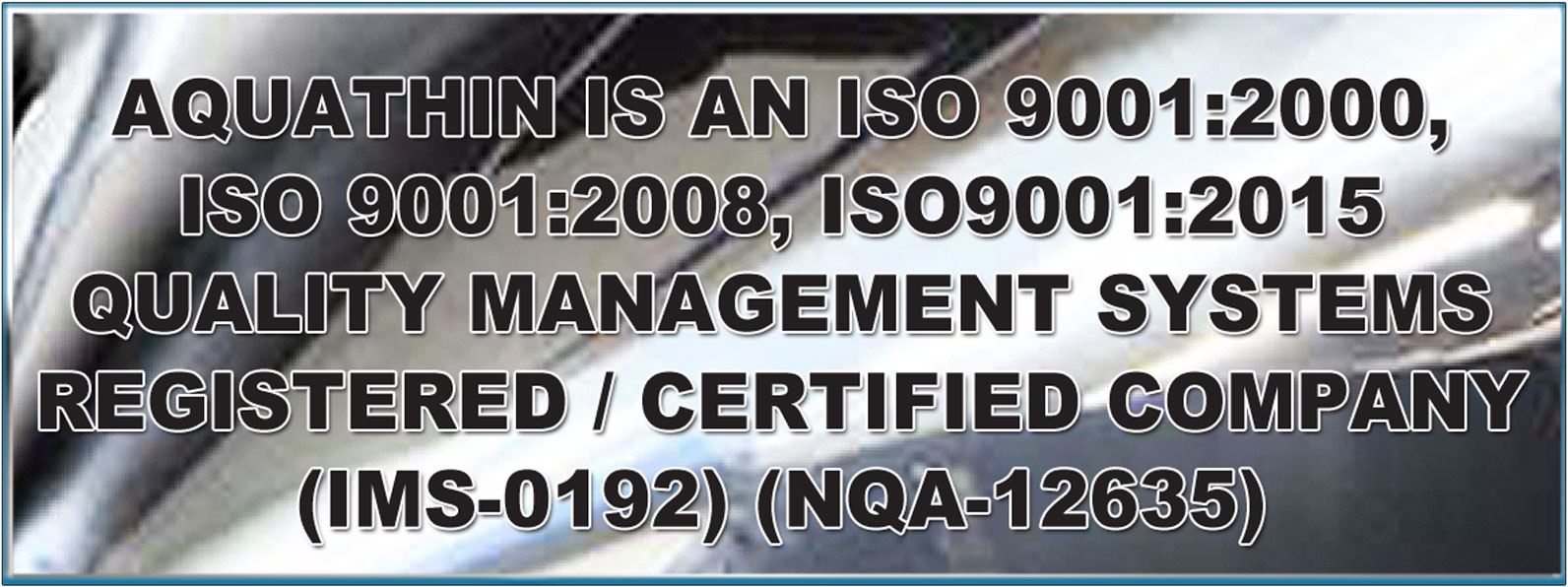Forum Q & A: Water Softener
Dear Aquathin Dealer On-Line;
Today's Q & A comes from a visitor to the website who wants to know all the benefits of soft water and how a water softener works.
Warmest regards,
Alfie
Soft Water: The Economical Solution
The modern economy doesn't leave a lot of room for unnecessary waste. A penny wasted here or a nickel there can add up to hundreds of dollars over the course of a year. An often overlooked budget waster is hard water and its effect on laundry. Hard water is often not an "obvious" problem to people who have not had the opportunity to compare it to soft water. It is usually difficult to see or taste any difference between hard and soft water. The minerals that make water hard (calcium and magnesium) are usually tasteless and completely dissolved.
The differences between hard and soft water become more obvious in bathing and cleaning, where hard water leaves a residue when combined with soap called "soap curd," which must itself be cleaned off. Hard water has similar effects on laundry.
Hardness minerals affect laundry in a gradual manner often not obvious in today's automated washing processes. People accustomed to hard water may not notice the increased detergent use, faster fading of colors or yellowing of whites, shortened fabric life, greater demand for hot water, increased wear on the washing machine, and extra wash and rinse cycles. But the waste is still there, slowly working away at the family budget. Fortunately, hard water can be softened, and soft water virtually eliminates these problems.
What is Hard Water?
Hard water is found throughout the world, and in about 85 percent of the United States, according to the U.S. Geological Survey. Hard water areas exist where water has access to rock that contains calcium, magnesium, or a combination of both.
The U.S. Department of the Interior has established levels for the classification of hardness based on the grains per gallon (gpg) concentration of these minerals. To put grains per gallon in perspective, a typical aspirin contains about 5 grains of material. Were this to be dissolved in a gallon of water, it would add 5 gpg of material to the water. Water in the 1 to 3.5 gpg range is considered slightly hard. If the water is in the 3.5 to 7.0 gpg range, it is considered to be moderately hard; hard water being between 7.0 to 10.5 gpg. Very hard water is defined as water with concentrations of dissolved minerals in excess of 10.5 gpg. The harder the water, the more it impacts laundry; and even moderately hard water can make a difference.
Wasteful Hard Water
It's difficult to imagine that such a small amount of calcium or magnesium dissolved in a gallon of water would have much of an effect, but the results can be far out of proportion to the concentration. Everything from soap's ability to clean to the life span of the washing machine can be affected. A study conducted by the American Institute of Laundering determined that detergent and laundering costs can be as much as twice as much in hard water as compared with soft water.
Listed below are some of the ways hard water adds its subtle waste.
Laundry Soap
Laundry soap was the primary cleaning agent for laundry prior to the development of synthetic detergents. Soaps are usually natural, made from fatty acids and alkali substances such as caustic soda, which give soap excellent cleaning properties, particularly with vegetable-based fabrics like cotton. Soap works well to suspend dirt in the wash (keep it in the water until it goes down the drain), and helps "lubricate" the fabric, prolonging its life. Another advantage is that soaps are generally made up of ninety percent or more active cleaning agent, which reduces the amount required for use. Unfortunately, hardness minerals combine with soap to form an insoluble "curd," which can remain as a residue on washed laundry. This is similar to the difficult-to-clean residue found on bathroom tubs, sinks, and tile in hard water areas.
Hardness also tends to counteract soap's alkalinity, which reduces its cleaning ability and requires the use of greater quantities to get laundry clean. A partial solution to this problem is the addition of "builders" such as complex phosphates, silicates, or sal-soda, which can be added to counteract hardness. Builders boost the alkalinity of the wash, improving its cleaning ability, and helping to neutralize acid soil and hardness minerals. However, builders do not prevent the formation of soap curd.
Laundry Detergent
Synthetic detergents based on petroleum were introduced in the 1950's primarily to overcome hard water's soap curd problem. Unlike unbuilt soaps, which are greater than 90 percent active ingredients, unbuilt detergents contain only 20 to 40 percent active ingredients, and 50 to 65 percent neutral salts, a manufacturing byproduct. The remaining ingredients are surfactants (which lower water's surface tension and improve its wetting ability), suspension agents (which keep the dirt suspended in the water), whitening agents, and cosmetic additives.
Alone, synthetic detergent is generally neutral and does not create the alkaline cleaning environment soap does. Most modern detergents also contain builders, but in much greater quantities than soap. Unfortunately, the builders tend to be consumed in softening hard water. This limits their ability to clean, and requires greater quantities of detergent to be used to get laundry clean.
Rinse Cycles and Water Temperature
It's a well known fact that the hotter the water the cleaner the laundry, and this is particularly true in hard water. Hard water's effect on soap and detergent, which reduces cleaning ability and hampers the rinse, means hotter water and extra rinse cycles may be required to clean laundry. The energy used to heat water and to operate the washing machine for extra cycles translates to higher costs and wasted expense to consumers.
Fabric Life and Appearance
A Purdue University study found that fabrics washed in hard water tend to wear out as much as 15 percent faster than fabrics washed in soft water. This is probably due to the presence of hardness residues left in the fabric after laundering, making it stiffer and causing increased friction and wear on the fabric as it flexes.
The Purdue study also found that hard water has a generally negative effect on colors and whites. Colors were found to fade and whites to darken more quickly in hard water. In addition, the study found that laundry washed in hard water became resoiled with greater ease.
Washing Machines
The dissolved minerals in hard water tend to collect in water-using appliances, shortening their life. Washing machines are not immune to this process, and the buildup of these minerals can clog pipes and cause excessive wear on moving parts. A study by the American Water Works Association (AWWA) found that washing machines used with hard water can wear out up to 30 percent faster. A washing machine, which might otherwise last 10 years, will likely last as few as 7 years where hard water deposits can be formed.
Solutions
The best solution to these hard water problems is to use a soft water. This was realized by earlier generations who coined the phrase "hard water" because they found it hard to wash with. They collected soft rainwater in a barrel to be used for laundering, which is hardly an option in the modern world of indoor plumbing and automatic washing machines.
Some water utilities offer municipal softening, but water treated in this manner falls short of being soft water. Municipal softening treatment is generally found in areas with extremely hard water, and the end water is still often in the hard to moderately hard range. Municipal softening is also inefficient because all of the community's water is softened, including water that is ultimately used to water lawns and clean public streets. Household water softeners generally provide the most economically effective source of soft water for home and business use.
A typical water softener works on the principal of "cation exchange," in which the ions of hardness minerals (an ion is an electrically charged atom or group of atoms) like calcium and magnesium are exchanged for sodium ions, effectively reducing the concentration of hardness minerals to insignificant levels.
As the water enters the softener, it passes over a resin bed in a special tank. The resin is made up of tiny beads of a plastic called styrene linked together by a compound called divinylbenzene. These beads attract and hold sodium or potassium ions. The beads will exchange sodium or potassium for hardness ions such as magnesium or calcium whenever the hardness ions are encountered. The beads are biologically safe, and approved for use by the U.S. Food and Drug Administration (FDA).
After a period of use, the sodium or potassium ions are completely exchanged and the unit has to be "backwashed" or "regenerated," which recharges the resin beads with sodium and potassium ions. This requires the use of sodium or potassium chloride, which is loaded into a "brine tank" where salt dissolves in water, forming the brine which is used to recharge the system. The recharging is most often done in one of two ways. Automatic softeners initiate the regeneration process on a set schedule based to anticipated need; Demand Initiated Regeneration (DIR) softeners use a meter or sensor to monitor the actual hardness levels, or the amount of water a unit has processed, to determine when backwashing is necessary.
Conclusion
The waste hard water creates each year can cost hundreds of dollars in extra detergent use, unnecessary rinse cycles and hot water use, fabrics that lose their usefulness, and washing machines that wear out before their time. Soft water greatly reduces this waste, and gets laundry cleaner as well. And these benefits are in laundry expenses alone.
Many of softened water's benefits apply to other areas of the home or business. Bathroom and kitchen fixtures stay cleaner without the formation of soap curd, water heaters operate more efficiently and last longer, dishes get cleaner with less detergent and dishwashers last longer, and even bathing is free of hard water deposits which dry skin and dull hair. When it all adds up, hard water is a waste that can be done without.
This article first appeared in the WaterReview Technical Brief, (1993) Volume 8, No. 1; a publication of the Water Quality Research Council. Copyright 1993, 1995 by the WQA. All rights reserved.


